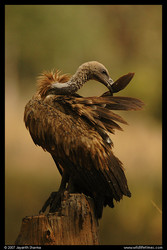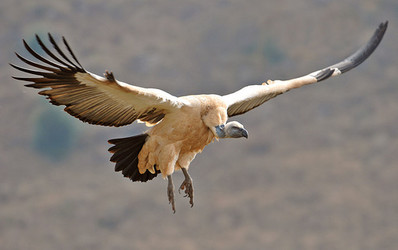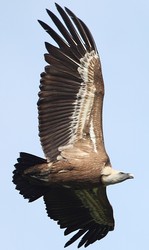Gyps
Julia Gulka and David P. Mindell


This tree diagram shows the relationships between several groups of organisms.
The root of the current tree connects the organisms featured in this tree to their containing group and the rest of the Tree of Life. The basal branching point in the tree represents the ancestor of the other groups in the tree. This ancestor diversified over time into several descendent subgroups, which are represented as internal nodes and terminal taxa to the right.

You can click on the root to travel down the Tree of Life all the way to the root of all Life, and you can click on the names of descendent subgroups to travel up the Tree of Life all the way to individual species.
For more information on ToL tree formatting, please see Interpreting the Tree or Classification. To learn more about phylogenetic trees, please visit our Phylogenetic Biology pages.
close boxReferences
Arshad, M., Gonzalez, J., El-Sayed, A. A., Osborne, T., and Wink, M. 2009. Phylogeny and phylogeography of critically endangered Gyps species based on nuclear and mitochondrial markers. Journal of Ornithology 150: 419-430.
Johnson, J. A., Lerner, H. R. L., Rasmussen, P. C., and Mindell, D. P. 2006. Systematics within Gyps vultures: a clade at risk. BMC Evolutionary Biology 6: 65.
Title Illustrations

| Scientific Name | Gyps indicus |
|---|---|
| Location | Madhya Pradesh, India |
| Specimen Condition | Live Specimen |
| Behavior | Preening |
| Source | Long-billed Vulture - Preening |
| Source Collection | Flickr |
| Image Use |
 This media file is licensed under the Creative Commons Attribution-NonCommercial-NoDerivs License - Version 2.0. This media file is licensed under the Creative Commons Attribution-NonCommercial-NoDerivs License - Version 2.0.
|
| Copyright | © 2007 Jayanth Sharma |
| Scientific Name | Gyps coprotheres |
|---|---|
| Location | The Rhino and Lion Nature Reserve in Muldersdrift, South Africa |
| Specimen Condition | Live Specimen |
| Source | Truely Free! |
| Source Collection | Flickr |
| Copyright |
© 2008 Callie de Wet

|
| Scientific Name | Gyps fulvus |
|---|---|
| Location | Italy |
| Specimen Condition | Live Specimen |
| Source | Grifone |
| Source Collection | Flickr |
| Image Use |
 This media file is licensed under the Creative Commons Attribution-NonCommercial-ShareAlike License - Version 2.0. This media file is licensed under the Creative Commons Attribution-NonCommercial-ShareAlike License - Version 2.0.
|
| Copyright | © 2010 Lorenzo Magnis |
About This Page

Middlebury College, Middlebury, Vermont, USA
David P. Mindell

California Academy of Sciences, San Francisco, California, USA
Correspondence regarding this page should be directed to Julia Gulka at and David P. Mindell at
Page copyright © 2011
 Page: Tree of Life
Gyps.
Authored by
Julia Gulka and David P. Mindell.
The TEXT of this page is licensed under the
Creative Commons Attribution-NonCommercial License - Version 3.0. Note that images and other media
featured on this page are each governed by their own license, and they may or may not be available
for reuse. Click on an image or a media link to access the media data window, which provides the
relevant licensing information. For the general terms and conditions of ToL material reuse and
redistribution, please see the Tree of Life Copyright
Policies.
Page: Tree of Life
Gyps.
Authored by
Julia Gulka and David P. Mindell.
The TEXT of this page is licensed under the
Creative Commons Attribution-NonCommercial License - Version 3.0. Note that images and other media
featured on this page are each governed by their own license, and they may or may not be available
for reuse. Click on an image or a media link to access the media data window, which provides the
relevant licensing information. For the general terms and conditions of ToL material reuse and
redistribution, please see the Tree of Life Copyright
Policies.
- First online 31 July 2011
- Content changed 31 July 2011
Citing this page:
Gulka, Julia and David P. Mindell. 2011. Gyps. Version 31 July 2011 (temporary). http://tolweb.org/Gyps/57823/2011.07.31 in The Tree of Life Web Project, http://tolweb.org/











 Go to quick links
Go to quick search
Go to navigation for this section of the ToL site
Go to detailed links for the ToL site
Go to quick links
Go to quick search
Go to navigation for this section of the ToL site
Go to detailed links for the ToL site